AUBERGINE IN THE BEKAA
TEXT: JENNY GUSTAFSSON
PHOTOS: JENNY GUSTAFSSON
RESEARCH: RANA HASSAN
EDITS: NISREEN KAJ
Making makdous with three generations

Safieh Abdel Naser Alasafa (who goes by the name Safaa) and her daughter in their home in Qab Elias in the Bekaa Valley
The scene in the small garden of Safieh Abdel Naser Alasafa (who goes by the name Safaa) near Qab Elias in the Bekaa Valley clearly hints at what is happening inside her home.
Small pieces of aubergine have been left to dry in a sunny corner, next to a large bowl filled to the rim with the same vegetable.
Two of Safaa’s children, Assina and Menissa, come out through the door and begin placing the aubergines in boxes before carrying them inside. Their mother is already there, as is their grandmother, Basha Mahmoud Alabdullah, seated near the windows in the large living room. She rests her hands on her lap, waiting quietly as Safaa goes back and forth to bring bowls, jars, and other equipment.

“We are making the first batch of makdous for the year,” she says, as she puts the things down next to her mother.
It is the end of August, right when people across Syria, Lebanon, and elsewhere start making the much-loved makdous – small aubergines stuffed with walnuts and chili, covered in olive oil, and kept for the cold winter season.
“We have already started to prepare these aubergines, we boiled them slightly and will use them today,” Safaa says, pointing to the vegetables brought in from the garden.
“Sometimes, if we have very large quantities, we cook them in a pot outside over open fire.”
As unimpressive as it may look when boiled – brownish and soft, without the glimmer of its peel – the aubergine is the real star of makdous.
A berry by strict botanical qualification, it is related to the tomato and potato and comes in a number of different forms. The chubby, purple aubergine is perhaps what first comes to mind, but there are many more. Some are tiny, others weigh up to two kilos. There are aubergines with a midnight blue or green peel, and some with a milky white color (this is where the word eggplant comes from). Elongated varieties are popular in China. Miniature brinjal, the aubergine’s subcontinental name, are grown in parts of India.
Around the Mediterranean, a handful of varieties are commonly grown and used for different purposes.
“We grow three kinds of aubergine. The main one called Tatfi, a red or purple kind called Almasi, and a white variety,” Safaa’s husband, Hassan Mohammad Alasafa, says.
He shows images of the vegetable on his phone, taken at the two lands the family cultivates, not far from where they live. One is a field they rent for themselves, while the other is a larger piece of land shared with members of the agricultural cooperative Rizk El Wefeq. The couple and their children, aged from six to 15, come from Idlib in northwestern Syria and have lived in Lebanon since 2014, a couple of years after the war in their homeland began.

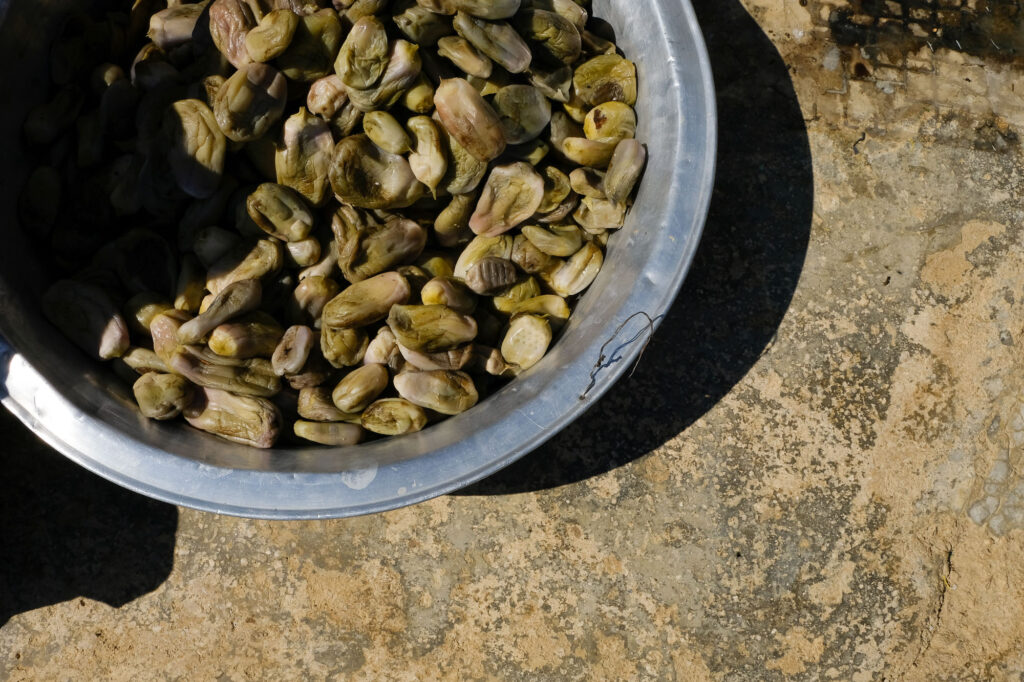
For makdous, you need small aubergines that are boiled and pressed to release all water before being sutffed with walnuts and chili

“But we used to come to Lebanon long before that. We did seasonal work here, staying for around eight months at a time,” Safaa says.
The first time she came to the Bekaa Valley was at the age of 12. Her mother, before her, the same. They would come with the family and work in the exact same area where they now live, harvesting crops like potatoes and beetroots.
“I remember walking into the field and the beetroot plants were taller than us,” Safaa says.
Each year, they would do the same thing: come at the beginning of the season, work together, save their earnings, and return to Syria when the last harvest was over.
“Before leaving, we women would go and buy things for the house – blankets, plates, cups, bedsheets – because they were all cheaper and nicer than what we would find in Syria,” Safaa says.
She has started with the filling for the makdous, assisted by her mother. They peel garlic until they have a small mountain of white cloves, then add them to the chopped walnuts and red peppers, sun-dried in the garden just like the pieces of aubergine.
“Once, we had to use peanuts instead of walnuts. This was during the war when we could not harvest and there were no walnuts available,” Safaa says.
Whatever the circumstances, makdous remains one of the most popular kinds of preserved foods, mouneh, made in Syria, Lebanon, and neighboring countries. The term includes anything from dried herbs and cheeses to marmalades and tangy pickles, and comes from the word mawwan, which means to store. This is the idea behind mouneh, to take what is in season and store it for later on.
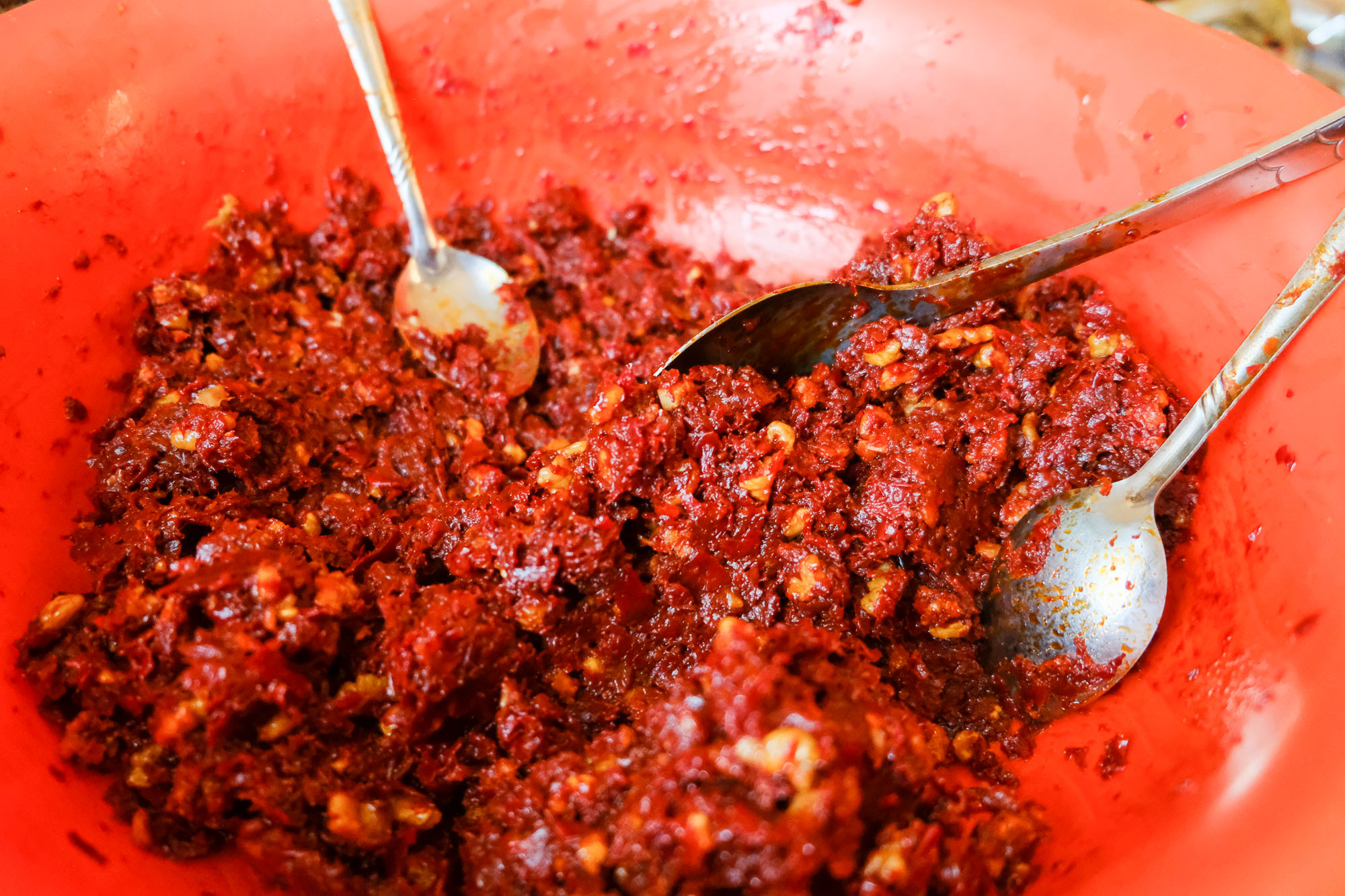

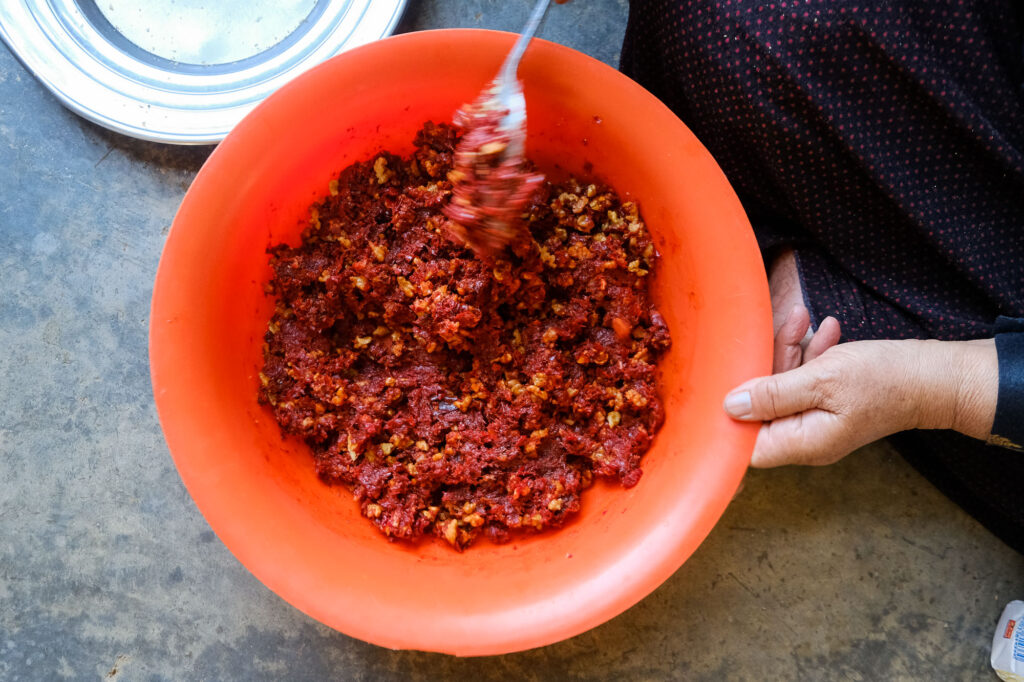
Food preservation has been practiced in this region for a very long time. Evidence shows that people were actively drying foods in the sun as early as 12,000 BC. Barbara Massaad, a chef and author, calls mouneh a “living tradition” that continues to be refined “through the generations by culture and creativity.” It is, she says, “the building blocks” of Lebanon’s culinary heritage. This applies equally to Syria, which has a shared history.
Recipes are often simple – dry something in the sun, cover it with salt, submerge it in olive oil – but yield good results only when you manage to perfect the technique, which requires watching, then trying, then doing it over and over again.
Different regions have their own traditions, depending on weather and what grows on the land. Baalbek, with its hot and dry summers, makes fermented kishk. The mountain towns of Rashaya and Hasbaya produce fruit jams and grape molasses. Zaatar is abundant in Lebanon’s north, as are olives pressed to oil in local olive presses. Orange blossom water – and precious quantities of concentrated aromatic oil – typically comes from the south, as does freekeh and many zohourat blends.
In Syria, as noted already by Ibn Khaldun in the 12th century, the Damascus rose is turned into rose water and pink sherbet drinks. Aged shankleesh or sorke cheese rolled in chili is popular on Syria’s coast, and often put in salads with tomato, onion, and olive oil.
But perhaps more than any other mouneh, Syria is associated with makdous. The name comes from the word for “pile up,” which refers to how the aubergines are stacked in the jar.
In Safaa’s kitchen, all the shelves are filled with jars. Some contain olives, others spices or her own dairy products.
“We have a goat. It usually gives birth in winter, so we get milk and make labneh and cheese,” she says.
She also preserves vegetables like zucchini and green beans, and makes her own tomato paste and jams. From her mouneh reservoir, she can easily build numerous entire meals.
“In winter we buy absolutely nothing, we eat from our own mouneh,” she says.
In the living room, her daughters help remove the top leaves from the boiled aubergines. They start eating them as snacks – the flavor, they say, is a bit like artichoke.

Safaa's mother, Basha Mahmoud Alabdullah, cuts walnuts for the makdous filling
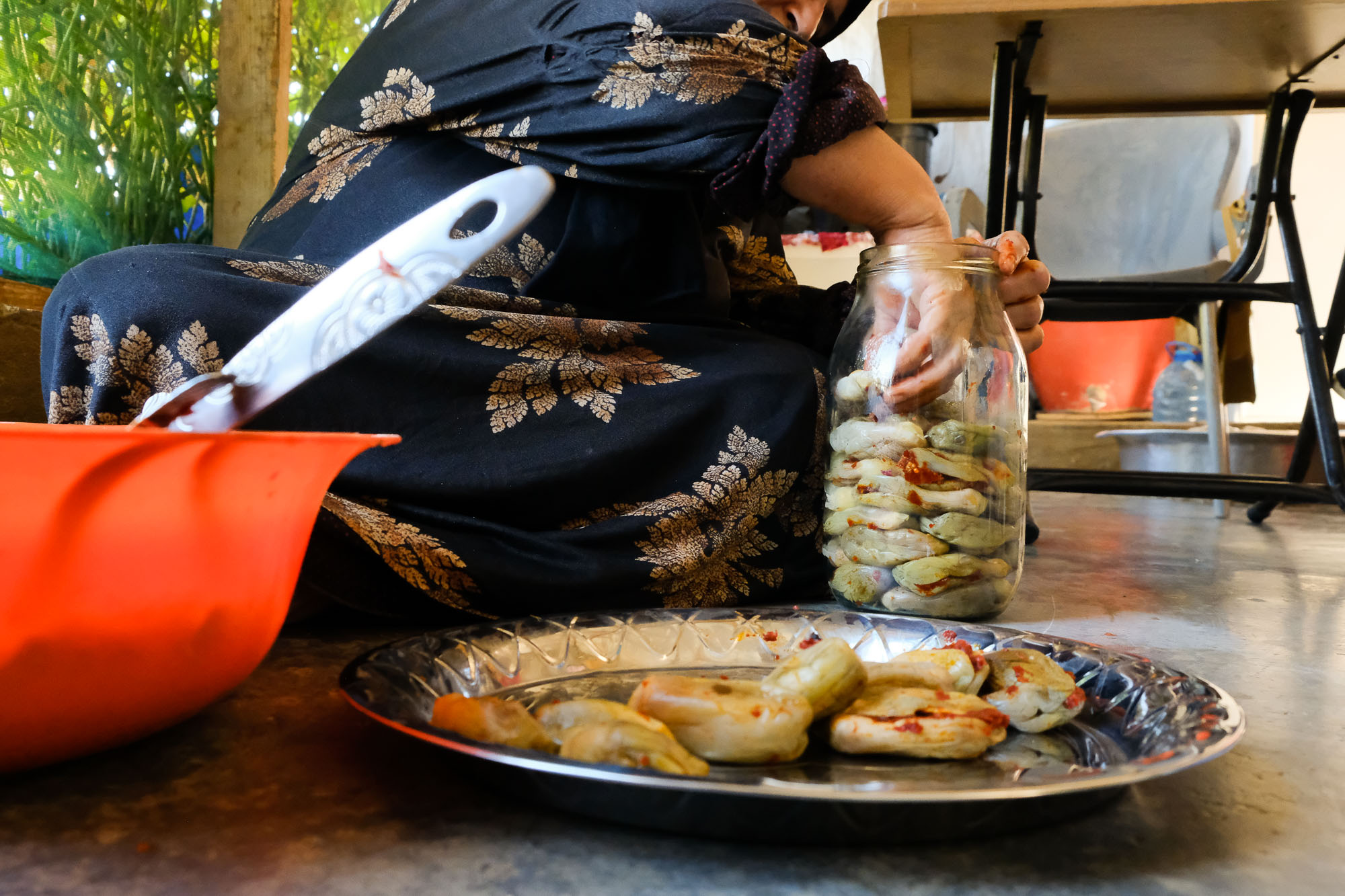
Safaa sometimes dries the tiny leaves, and puts them in stews along with chickpeas. She goes on to describe many other ways she cooks aubergine: grilled in the oven with peppers, zucchini, and meat; roasted and smashed into smoky mutabbal; cooked with parsley, tomato, garlic, and cumin to make a dish called mkhabbas.
“We even make jam from aubergine, the small reddish variety, which we peel and boil with sugar and water,” she says.
Add to these other regional specialties like maqloube or yalanji, both featuring the aubergine. The vegetable is popular in much of the Mediterranean region, where countless recipes are known.
A Syrian cookbook from as far back as the 13th century, Kitab Al Wusla Ila Al Habib, names 15 aubergine recipes, including for pickling, stewing, stuffing, and sautéing.
People in nearby regions like the Balkans, Armenia, and Georgia cook aubergine in similar ways. Georgian pkhali dip mixes walnuts and aubergine flesh; Balkan ajvar sometimes contains roasted aubergine. Otherwise, China is the largest aubergine-growing country in the world, and many regions of India (where it is referred to as “the king of vegetables”) use plenty of aubergine in their cooking.
China was also the point of departure for the cultivated aubergine’s inaugural journey to the Mediterranean. Its wild ancestor, long ago, grew in Africa, from where it spread through the Middle East and reached China, where it became domesticated some time before year zero. Chinese agronomists managed to change the plant from bearing small, green fruits to yielding large, long-necked aubergines with purple peel.
Different health benefits are mentioned in old Chinese texts, such as a treatise on “safe food” written by the dietician to the Mongol Emperor in 1330. Early Sanskrit documents in India also describe the aubergine, calling it things like shakasreshta, which means “excellent vegetable,” or rajakishmand, “royal melon.”
Eventually, long after its first arrival, the aubergine journeyed back to the Mediterranean, this time in its new, cultivated forms. It was brought by Muslim traders in the 7th and 8th centuries, and eventually spread in different directions from the sea. Ibn Awam, a prominent agriculturist from Muslim-era Sevilla, mentioned four types of aubergine in his 12th century book, Kitab Al Filaha: Syrian, Egyptian, “local,” and Cordoban.
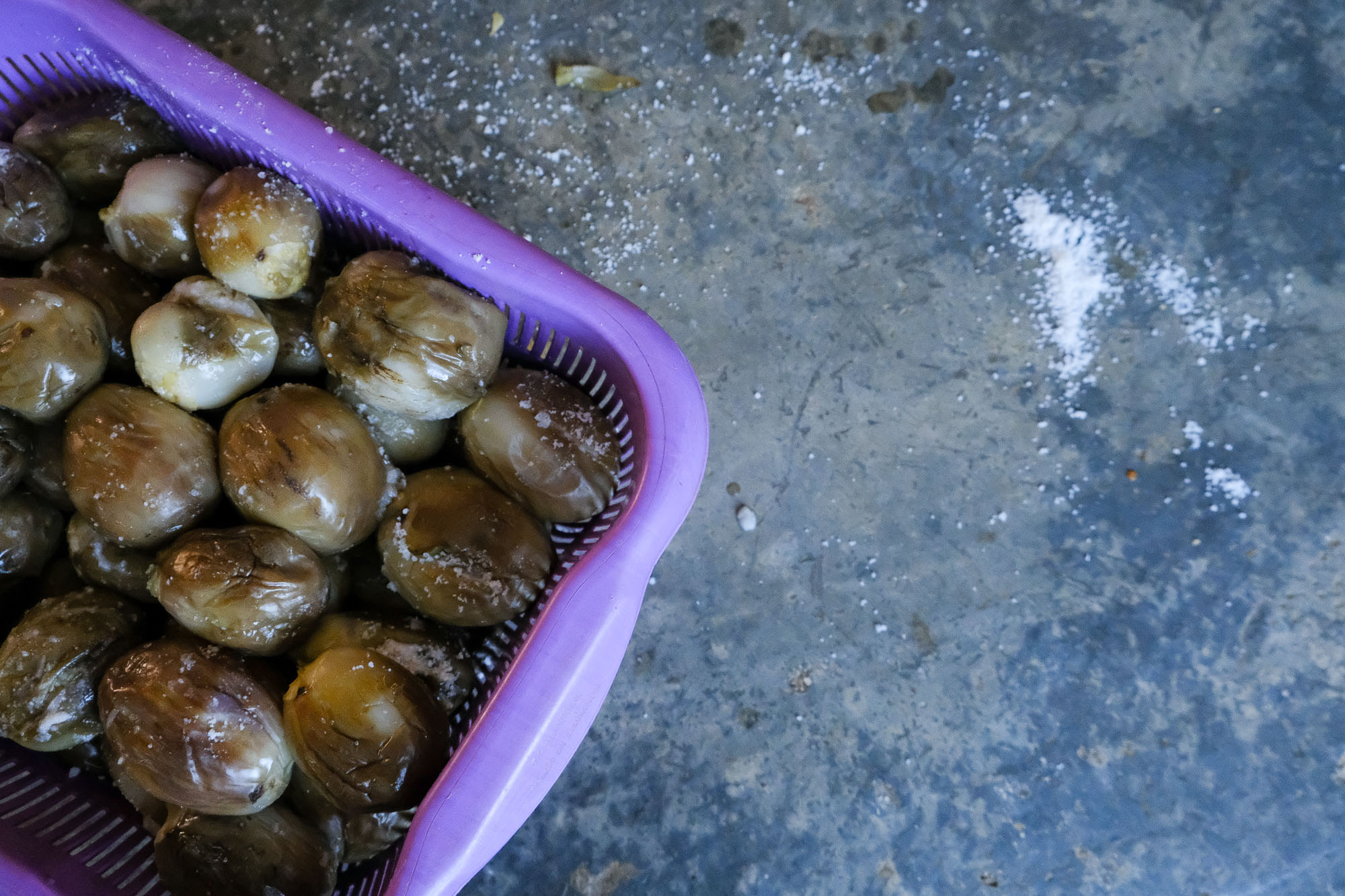
Often, Safaa and her relatives and neighbors gather and make large quantities of mouneh together
But throughout all of this, the vegetable fought an uphill battle. It was met with skepticism from early on, and there were many theories of its potential harmful effects, such as fever, melancholy, or even insanity (the name in Italian, “melanzana,” came to be misinterpreted as “mela insana,” insane apple). Historical Persian writers cited different diseases and conditions presumably resulting from consuming aubergine. Matthaeus Platearius, from the medical school in Salerno in current-day Italy, wrote that the bitterness and pungency of aubergine could cause an angry or depressive mood.
Perhaps this suspicion came from the plant’s belonging to the nightshade family, where some members are very poisonous. In Europe, it also had to do with its association to Jewish cooking. When Jews in Spain were forced to convert to Christianity or flee, aubergine recipes spread with their displacement and, given the persistence of anti-Jewish sentiments, gave the vegetable “an image of social and cultural marginality.”
In the eastern Mediterranean, it was the Turks who grew to love the aubergine perhaps more than anyone else. It would take until the 18th century, but the aubergine eventually became the Ottoman vegetable par excellence. It is said that stuffed aubergines cooked in the palace kitchens in Istanbul were sent as gifts across the city, which also had at least 50 shops in the 17th century known as “dolmaci,” specializing in stuffed vegetables. The aubergine was known as tarla baligi, meaning “fish of the fields.” At some point, it was fried in such quantities during summer that it resulted in “patlican yangini,” literally aubergine fires. And the winds blowing through Istanbul in August, fanning these fires, were called “patlican meltemi.”
A Turkish folktale, told in a few different versions, describes the coming into being of imam bayildi, “the imam fainted,” a popular dish with aubergine and lots of olive oil. The story (one of them) goes that an imam married the daughter of an oil merchant, who brought as dowry 12 jars of the finest olive oil. Each night, aubergine was prepared for the newlyweds, until day 13, when no aubergine arrived. When the imam heard that they were out of olive oil, he fainted.
In the living room, Safaa and her mother are done with making the filling. They have a larger batch than what is needed today; Safaa will save it and use it for other dishes.

“I will put it in the fridge for later or preserve it in a jar covered with oil,” she says.
She starts taking out the aubergines brought in from the garden. They have already been cut open and salted, more than two days ago, then left under the pressure of a heavy weight to be drained from all water. This is a crucial step for getting the right texture of the finished makdous.
“I learned to make makdous from my mother,” Safaa says and looks at Basha.
“And I learned it from my mother,” the grandmother replies.
“So, how did your mother learn?” one of the girls, sitting next to them, asks with a smile.
The two months that make up the mouneh season are the hardest time of the year, Safaa says. She is normally busy from morning to evening with work in the fields and at home, but during the mouneh season, more work is added. The family makes more mouneh now than when they just arrived in Lebanon and did not have any land.
“We made mouneh at that time as well, but not as much. It was expensive to buy all the ingredients you need,” Safaa says.
The lands they have now, both the rented plot and the field managed by Rizk w Wafa, give them an opportunity to be self-sustainable.
“It is very different when you have land. You plant what you want and the yield is yours to use,” she says.


“As soon as I hear about something, I want to try it." Safaa is experimenting with sesame seeds now, she says, after having started to grow saffron

Aubergine is one of the easier vegetables to grow, Safaa and her husband say. Similar to cucumber or zucchini, you just need to remove the weeds around the plants twice, then harvest. The family has a long experience of practicing natural agricultural methods, and continues to work like this on the lands in Qab Elias.
“In Syria, we never sprayed our fields. We always planted like this. There were no chemicals available in our village,” Hassan says.
Most members of the Syrian community in Lebanon, however, do not have the opportunity to work like this. Many work in conventional agriculture, which employs almost a quarter of all Syrians in the country and is an extremely informal sector.
With the arrival of large numbers of Syrians escaping the war, Lebanon became home to more refugees per capita than any other country in the world. But there is a long history of migration between the two countries, both temporary and long-lasting. Perhaps half a million Syrians (it is impossible to know exactly how many) already lived in Lebanon before the conflict started, and many of them did seasonal work like Safaa and her family. More than half of the Bekaa Valley’s agricultural workers were Syrians even before 2011.
The community is faced with discrimination when it comes to salaries and work conditions (in particular women, who systematically earn less than men), as well as instances of violence and racism (often mirroring political tension or animosity between the two countries). But for many Syrians, places in the Bekaa Valley are home.

“You can know a lot but you will still learn things. We are all learning.”
“We went to Beirut to get some things recently. On our way back, when we reached Chtoura, I thought we are back in our country! We have spent so many years here,” Safaa says.
The family is in the process of trying to migrate to Canada, if the paperwork goes through. They plan to continue working in agriculture, with their skills and experiences from here. If they go, Safaa says, the main thing that she will bring with her is mouneh.
“I will take all the foods I have made myself. The dried mint, the jams, the dried okra and aubergine, and the makdous.”
At the same time, she puts the last aubergines in the jar and fills it with oil. Not to the brim, as the summer heat makes the oil react and constantly spill over. She will place the jar on a tray and keep refilling it each time it spills over, before she finally can close the lid. Making makdous is a long endeavor.

